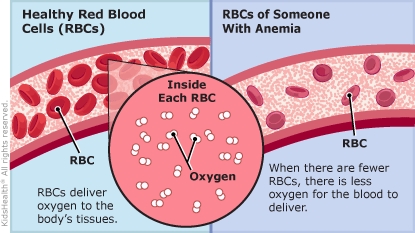Anemia: How to Care for Your Child

Anemia is when a person has a low number of red blood cells. Red blood cells are important because they carry oxygen from the lungs to the rest of the body. Oxygen helps all parts of the body work well.
Anemia happens when the body:
To find the cause of your child's anemia, the health care provider may need to order more tests.
Kids who have anemia may feel tired, weak, dizzy, or cranky. Other signs can include having pale or yellowish skin; having cold hands or feet; feeling less hungry than usual; fainting; having headaches, behavior problems, or a fast heartbeat; or feeling short of breath.

-
If the health care provider prescribed medicine or vitamins, give them as directed.
-
Most kids with anemia can play and do sports as normal, but some may need extra rest. Follow the health care provider's instructions about exercise and rest.
-
Give your child a well-balanced diet with foods from all five food groups: vegetables, fruits, protein, grains, and dairy.
-
Make any other diet changes recommended by the health care provider.
-
Return for recommended tests and follow-up visits.

Your child:
-
has blood in the toilet or with wiping
-
has bloody or black stool (poop)
-
has a heavy menstrual period
-
feels like their heart is beating fast or skipping beats
-
has new or worsening symptoms

Your child:

What causes anemia? Anemia can happen for many different reasons. Not eating the right kind of foods, taking some types of medicines, having an illness, or being injured can lead to anemia. In girls, heavy periods may lead to anemia.